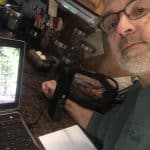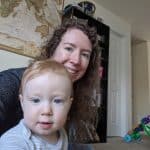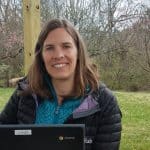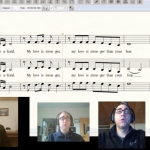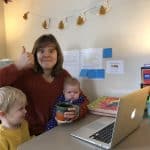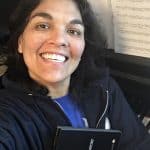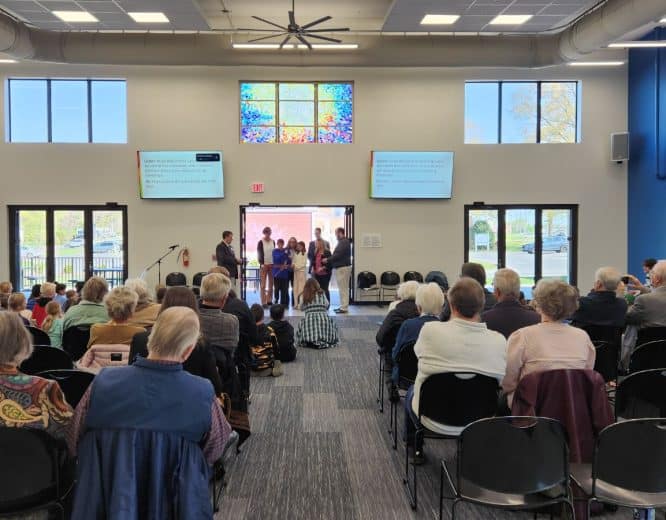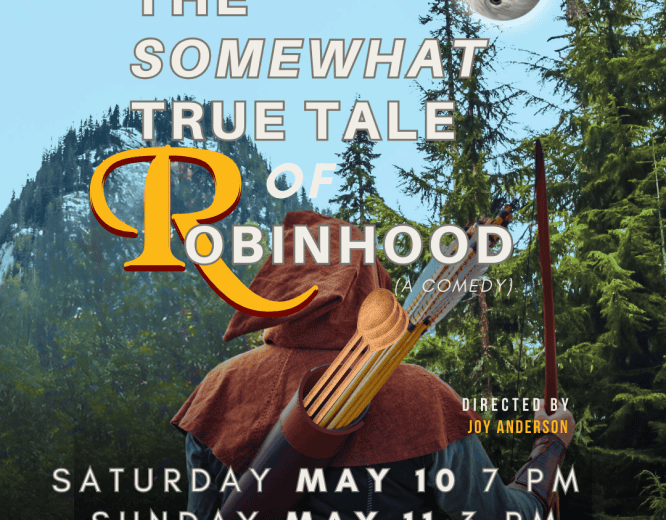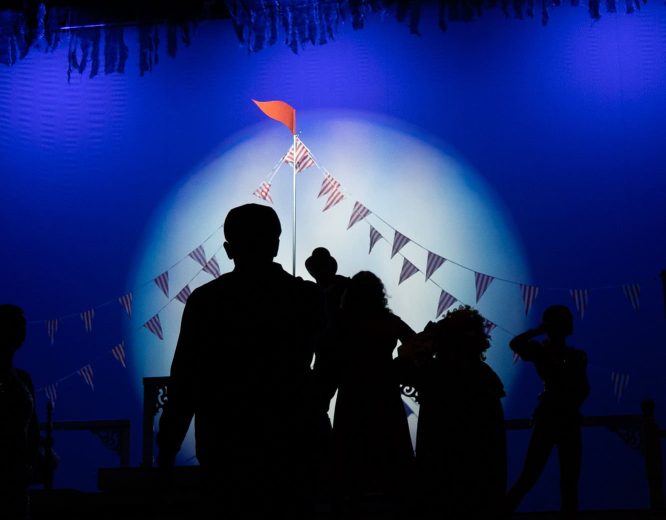EMS is #FlamesStrong in Online Mode
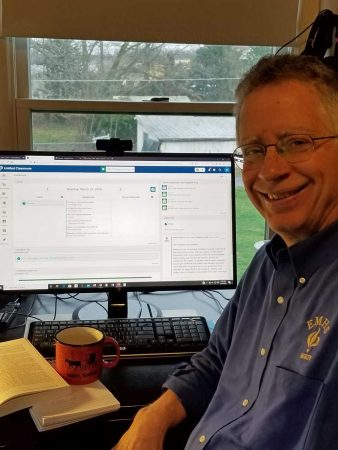
Sleeping in, reading for fun, hours outside… Along with all of this, EMS students continue to grow academically, socially and emotionally, through virtual community at Eastern Mennonite School this spring during the COVID-19 closure.
Some students wish for more online school work, while other students — and stressed parents — need less, observed Maria Archer, K-8 principal.
“Needs vary from day to day, as everyone navigates this strange new world,” she says. “We have the capacity to know our student and family needs and are doing our best to serve them.”
Justin King, high school principal, has been inspired by teachers’ creativity and commitment. “They have tackled new technology, made time to communicate with students, and learned to flex expectations and grading to accommodate emotional health. It’s been a lot,” he notes. “I’m so proud of them!
Online Academics
Since March 18, kindergarten through grade 12 classes have been meeting online, some synchronous (live) and others asynchronous, where students view content on their own time frame. Grades 6-12 work Mondays and Wednesdays on odd period classes, Tuesday and Thursday on even period classes, and use Friday as a “catch up” day.
More than 100 parents responded to a survey at the end of the first week. Most expressed appreciation for the content, teacher commitment, and ability for their students’ to continue academic work. Many also suggested ways to improve. In addition, nearly 100 students responded to another survey, this one circulated by the SCO (Student Council Organization).
“Responses provided incredibly valuable information to help shape the academic plan moving forward,” says King. “We read each one, looked for trends and made adjustments the next week,” says King. The principals also met virtually with each teacher to hear concerns, offer support and learn what has been working well.
Online learning samples
“My son woke up at 7 a.m. because he was so excited for Mr. Martin’s Friday challenge!” said one sixth grade mom. The egg drop challenge, obstacle course design and tin foil boat design “incorporate some of the skills we are learning in math or science into a challenge,” explains Larry Martin.
He also asks them to contribute to science lesson slideshows. “They can be creative and then look at how others are answering the questions,” he says. For example, students have made videos to “explain astronomically why we have seasons or eclipses. The videos are really creative, and it’s a good way for them to ‘see’ each other,” he says.
Malea Gascho, art teacher, sent students home with supplies for various classes. She created this video for her watercolor students to continue their class.
Anna Haarer, family and consumer science teacher, hosted a virtual smoothie lab in her home kitchen, with students following along in their own kitchens.
Mary Cranston, high school English teacher, has led AP literature class synchronously online.
Valeria Eshleman-Robles and Rebecca Yutzy created this Spanish video from their houses across the street from each other in Park View. “We call it “Nailed It, Park View” because “Nailed it, Mexico” is our students’ favorite Spanish-language show but we both live in Park View, across the street from each other,” Yutzy explains. “Viewers should pay attention to the end,” warns Yutzy, “because one of us made a big mistake that will affect the outcome of the cake!”
Faith Formation Online
In the days immediately following the closure, Jared Stutzman, choir director, found solace in creating a virtual choir that included all his current choral students, faculty, staff and alumni. Since posting the virtual choir performance of “Don’t Be Afraid,” by John Bell, more than 25,000 people have viewed it on Facebook and YouTube.
Elwood Yoder, in his 39th year of teaching, moved his classes online. They include: Kingdom Living, a senior level class; 9th grade Creation and Promise Bible class; and Global Christianity, a Bible and social studies elective. “These are places where I’m meeting my kids with faith, encouragement, and regular Bible study.”
“Mini chapels” for grades 6 to 12 featuring faculty, staff and students are posted several times a week, and students are assigned in their PowerSchool learning system to watch at their own pace.
Elementary students continue to enjoy their weekly Gathering, which normally takes place Wednesday morning. Maria Archer reads a book, shares and prays with them now in a video. She also posted a video of their annual Passion Walk for students to watch during Easter week.
The girls varsity soccer team captains asked Coach Andrew Gascho, if the team could have a weekly Bible study after an initial Zoom team meeting they had to process the loss of their season. The time of connecting and studying the book of Ephesians has been meaningful to the team, as well as coach. Read more.
Social and Emotional Well-being Online
All elementary grades have done virtual “circles,” reports Heidi Byler, third grade teacher and elementary team leader.
“We invite students to a video meeting, check in with a question, and draw names to hear from everyone who wants to share.” It’s a way to keep fostering the community, the listening and sharing, and just general wellness, she explains. Examples of questions include: what are the losses or gains you are experiencing? How have you been creative? What are you reading?
Byler also sent out video “wellness moments” that includes things like yoga stretches, breathing exercises, and a prayer shared by a local pastor. Teachers have also had video check-ins with small groups and/or one-on-one.
Debbie Katz, high school counselor, and Jodi Hertzler, college and career counseling, have met 1:1 with seniors to discuss their plans after graduation. “Many high school students are feeling ‘stuck’, understandably so, and are having a hard time making decisions,” says Katz. Joining Debbie and Jodi’s skill sets in these meetings has been well received by parents, according to King.
Gini Trotter, K-8 counselor, is holding virtual grade-level meetings with the 7th and 8th grade students, often separated by gender, to foster interaction and connection.
Student Council Organization (SCO) hosted a virtual Spirit Week for grades 6-12 and K-5 during spring break, inviting students to send photos and videos on themes for each day, such as “Whatcha Making’ Monday.” Daily video compilations of submissions are posted on the school’s YouTube channel.
Junior class representatives joined junior class sponsors and Justin King, high school principal, to dress up for a video announcing that they are, indeed, planning on a Junior-Senior banquet… sometime.
Joy Anderson, past musical director, and Jodi Hertlzer, drama coordinator, created a fun video to reveal the selected musical — Les Miserables — for next academic year and lay the groundwork for important conversations leading up to auditions and the production.
Laura Hershey Herr, pre-calculus teacher and middle school team leader, is one of many high school teachers who host Google meet “office hours” where students can connect and just say hi or ask questions.
The list of the ways we are connecting could go on, notes Paul Leaman, head of school. “Like our entire nation, we are learning that we need each other now more than ever. We are grateful for tools that help us connect and our capacity as a school community to be here for each other.”
Learn more about EMS during the COVID-19 closure and support the school’s COVID-19 Aid Fund.
The photo gallery at right features teachers during the first week of online teaching from their home offices.

